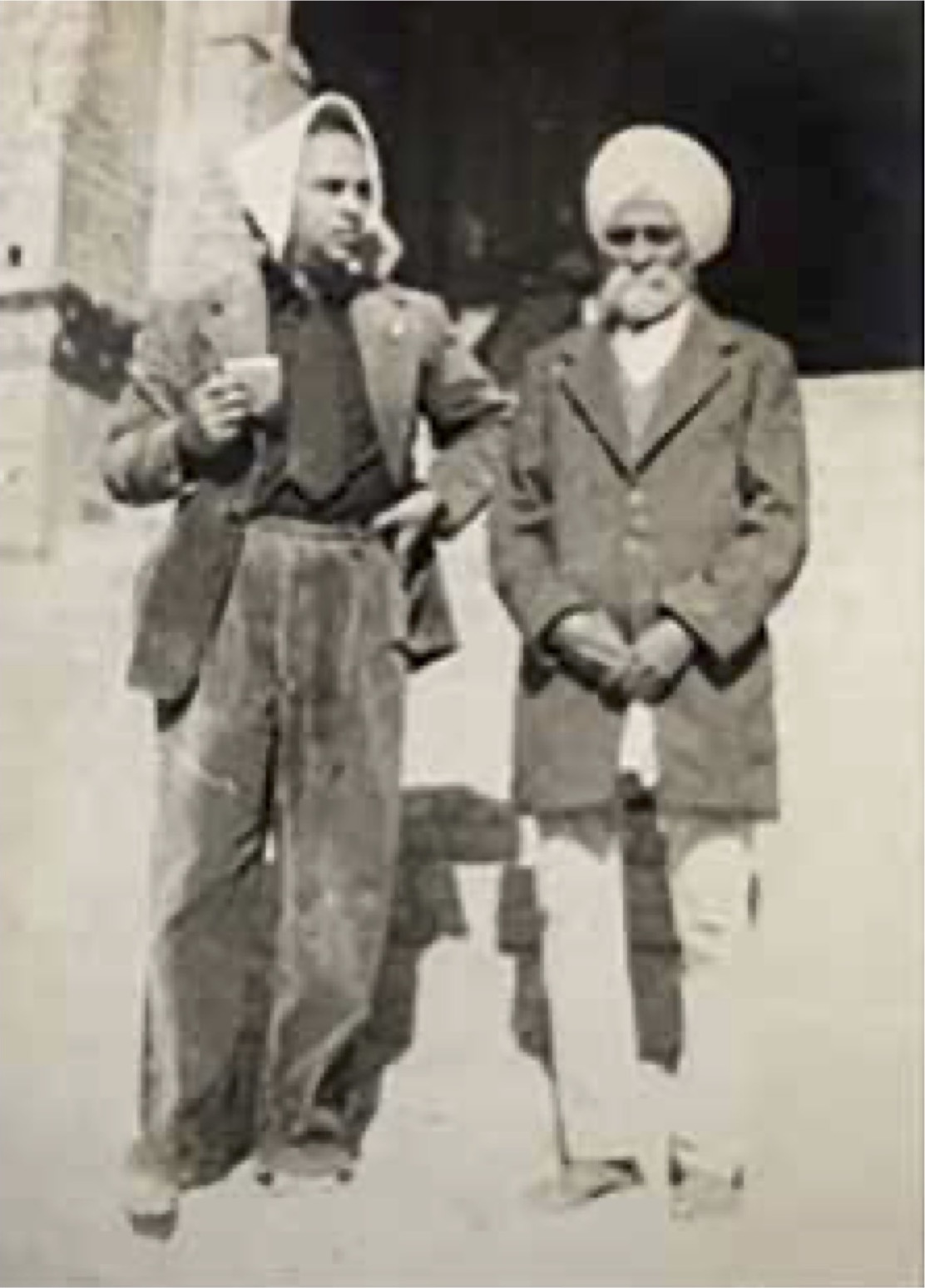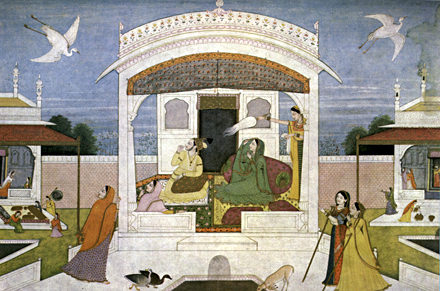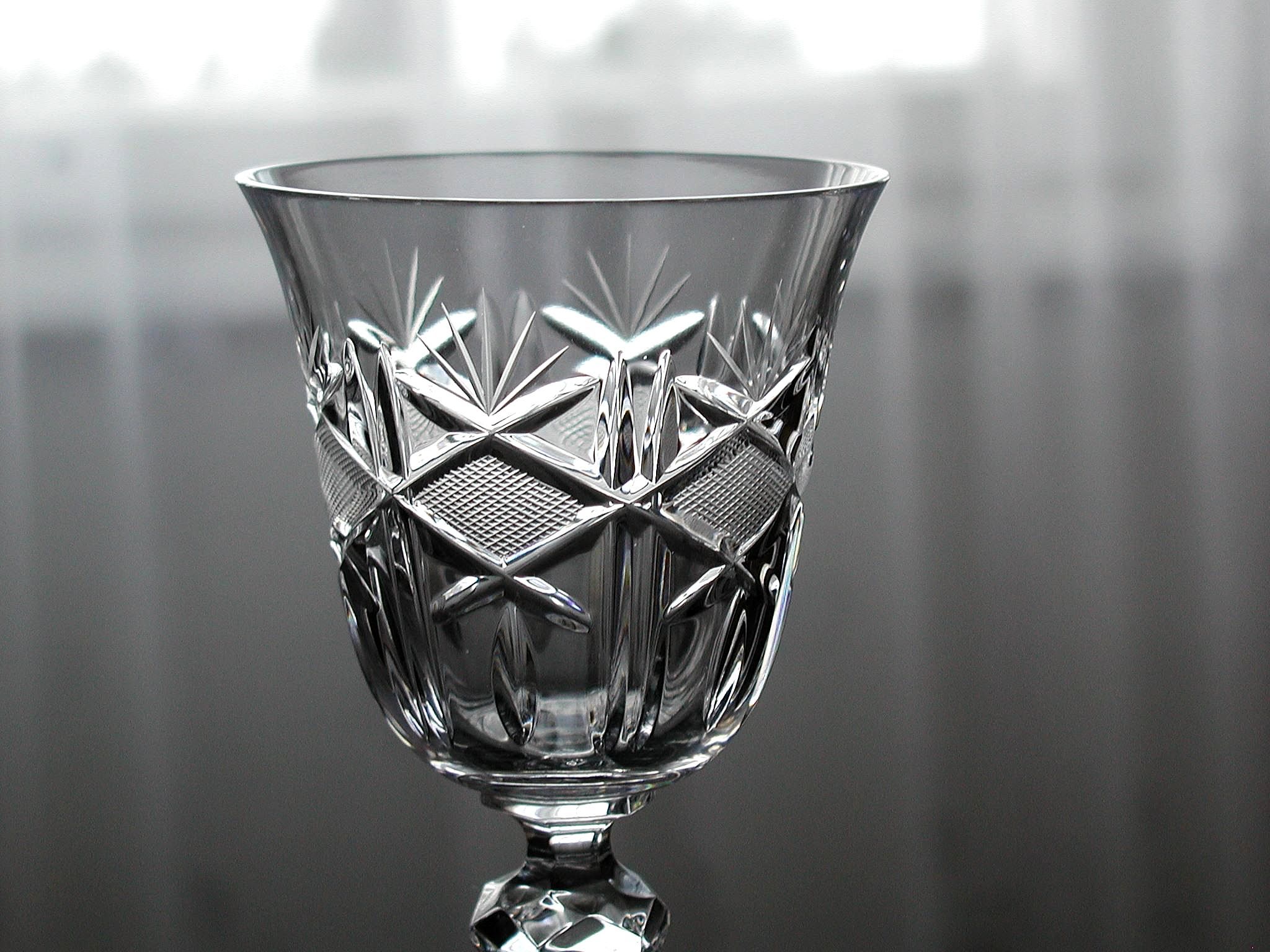|
Gian Singh Naqqash
Gian Singh Naqqash (1883 – 1953) was a Punjabi Sikh artist. He was a fresco painter and worked at the Golden Temple for more than 33 years. He is particularly known for painting in the style that is known as the Sikh School of Painting. Biography Early life Gian Singh was born in 1883 in Amritsar, British Punjab (now Punjab, India). His family had no prior background in art. His father was Charan Singh or Taba Singh, who worked as a comb-maker. As a child, he was a student of Giani Thakur Singh, a Sikh missionary and academic. He studied until the 5th standard. Later-on after finishing primary school, he became the apprentice of Nihal Singh Naqqash, son of Bishan Singh and a third generation descendant of Kehar Singh Naqqash, whom had worked under the patronage of Maharaja Ranjit Singh. He studied drawing and painting under Nihal Singh. He remained a student of Nihal Singh for 14 years until the latter's death in 1905. After Nihal Singh's death, he was instructed by Ni ... [...More Info...] [...Related Items...] OR: [Wikipedia] [Google] [Baidu] |
Punjabi Sikhs
Punjabi Sikhs are adherents of Sikhism who identify Natural language, linguistically, culturally, and Genealogy, genealogically as Punjabis and are native of Undivided Punjab region of Indian Subcontinent. Sikhism is an Indigenous religion, Indigenous religion born and brought up in Punjab region of South Asia during 15th century. Almost 96% of world's Sikh population are Punjabis. While Punjabi Sikhs are mostly found in the Indian state of Punjab, India, Punjab today, many have ancestry from the Punjab region, greater Punjab region, an area that was Partition of India, partitioned between India and Pakistan in 1947. In the contemporary era, Punjab Sikhs are found in large numbers across the Indian states of Punjab, Haryana, Himachal Pradesh, Uttarakhand, Delhi, Chandigarh, Rajasthan and Maharashtra. Large numbers are also found in the United States, Canada, Australia, New Zealand and United Kingdom, Britain, as various immigration waves over the centuries better prospects and ... [...More Info...] [...Related Items...] OR: [Wikipedia] [Google] [Baidu] |
Waheguru
''Waheguru'' ( pa, ਵਾਹਿਗੁਰੂ, translit=vāhigurū, translit-std=IAST) is a word used in Sikhi to refer to God as described in ''Guru Granth Sahib''. The meaning of the word (usually spelled in English as ''Waheguru'') is traditionally explained as 'wondrous!', and ''guru'', Sanskrit for 'teacher, spiritual guide, God', which taken together are said to carry the meaning, 'Wondrous Lord'. The hymns to Waheguru contained in ''Guru Granth Sahib'' have been composed by Bhatt Gayand. The word is also used in Sikhism as a main mantra and is called ''gurmantra'' or ''gurmantar''. By praising the Waheguru one can clear their mind and heart. According to Bhai Gurdas, a devoted Sikh of many of the Gurus and the scribe of the Adi Granth The Guru Granth Sahib ( pa, ਗੁਰੂ ਗ੍ਰੰਥ ਸਾਹਿਬ, ) is the central holy religious scripture of Sikhism, regarded by Sikhs as the final, sovereign and eternal Guru following the lineage of the ten human gur ... [...More Info...] [...Related Items...] OR: [Wikipedia] [Google] [Baidu] |
Photograph Of Bhai Gian Singh Naqqash Painting Toys In His Later Years
A photograph (also known as a photo, image, or picture) is an image created by light falling on a photosensitive surface, usually photographic film or an electronic image sensor, such as a CCD or a CMOS chip. Most photographs are now created using a smartphone/ camera, which uses a lens to focus the scene's visible wavelengths of light into a reproduction of what the human eye would see. The process and practice of creating such images is called photography. Etymology The word ''photograph'' was coined in 1839 by Sir John Herschel and is based on the Greek φῶς ('' phos''), meaning "light," and γραφή (''graphê''), meaning "drawing, writing," together meaning "drawing with light." History The first permanent photograph, a contact-exposed copy of an engraving, was made in 1822 using the bitumen-based " heliography" process developed by Nicéphore Niépce. The first photographs of a real-world scene, made using a camera obscura, followed a few years later at ... [...More Info...] [...Related Items...] OR: [Wikipedia] [Google] [Baidu] |
Oil Painting
Oil painting is the process of painting with pigments with a medium of drying oil as the binder. It has been the most common technique for artistic painting on wood panel or canvas for several centuries, spreading from Europe to the rest of the world. The advantages of oil for painting images include "greater flexibility, richer and denser colour, the use of layers, and a wider range from light to dark". But the process is slower, especially when one layer of paint needs to be allowed to dry before another is applied. The oldest known oil paintings were created by Buddhist artists in Afghanistan and date back to the 7th century AD. The technique of binding pigments in oil was later brought to Europe in the 15th century, about 900 years later. The adoption of oil paint by Europeans began with Early Netherlandish painting in Northern Europe, and by the height of the Renaissance, oil painting techniques had almost completely replaced the use of tempera paints in the majority ... [...More Info...] [...Related Items...] OR: [Wikipedia] [Google] [Baidu] |
Ayurveda
Ayurveda () is an alternative medicine system with historical roots in the Indian subcontinent. The theory and practice of Ayurveda is pseudoscientific. Ayurveda is heavily practiced in India and Nepal, where around 80% of the population report using it. Ayurveda therapies have varied and evolved over more than two millennia. Therapies include herbal medicines, special diets, meditation, yoga, massage, laxatives, enemas, and medical oils. Ayurvedic preparations are typically based on complex herbal compounds, minerals, and metal substances (perhaps under the influence of early Indian alchemy or ''rasashastra''). Ancient Ayurveda texts also taught surgical techniques, including rhinoplasty, kidney stone extractions, sutures, and the extraction of foreign objects. The main classical Ayurveda texts begin with accounts of the transmission of medical knowledge from the gods to sages, and then to human physicians. Printed editions of the '' Sushruta Samhita'' (''Sushruta's Compen ... [...More Info...] [...Related Items...] OR: [Wikipedia] [Google] [Baidu] |
Jallianwala Bagh Massacre
The Jallianwala Bagh massacre, also known as the Amritsar massacre, took place on 13 April 1919. A large peaceful crowd had gathered at the Jallianwala Bagh in Amritsar, Punjab, to protest against the Rowlatt Act and arrest of pro-independence activists Saifuddin Kitchlew and Satyapal. In response to the public gathering, the temporary Brigadier (India), Brigadier general, R. E. H. Dyer, surrounded the protesters with his Gurkha, Baloch, Rajput and Sikh from 2-9th Gurkhas, the 54th Sikhs and the 59th Scinde Rifles (Frontier Force), 59th Scinde Rifles of British Indian Army. The Jallianwala Bagh could only be exited on one side, as its other three sides were enclosed by buildings. After blocking the exit with his troops, he ordered them to shoot at the crowd, continuing to fire even as the protestors tried to flee. The troops kept on firing until their ammunition was exhausted. Estimates of those killed vary between 379 and 1500+ people and over 1,200 other people were injured of ... [...More Info...] [...Related Items...] OR: [Wikipedia] [Google] [Baidu] |
Pahari Painting
Pahari painting (literally meaning a painting from the mountainous regions: ''pahar'' means a mountain in Hindi) is an umbrella term used for a form of Indian painting, done mostly in miniature forms, originating from Himalayan hill kingdoms of North India, during 17th-19th century, notably Basohli, Mankot, Nurpur, Chamba, Kangra, Guler, Mandi and Garhwal. Nainsukh was a famous master of the mid-18th century, followed by his family workshop for another two generations. The central theme of Pahari painting is depiction of eternal love of Hindu deities Radha and Krishna. Origin and area The Pahari school developed and flourished during 17th-19th centuries stretching from Jammu to Garhwal, in the sub- Himalayan India, through Himachal Pradesh. Each created stark variations within the genre, ranging from bold intense Basohli Painting, originating from Basohli in Jammu and Kashmir, to the delicate and lyrical Kangra paintings, which became synonymous to the style before o ... [...More Info...] [...Related Items...] OR: [Wikipedia] [Google] [Baidu] |
Kangra Painting
Kangra painting (Hindi: कांगड़ा चित्रकारी) is the pictorial art of Kangra, named after the Kangra State, a former princely state of Himachal Pradesh, which patronized the art. It became prevalent with the fading of Basohli school of painting in mid-18th century, and soon produced such a magnitude in paintings both in content as well as volume, that the Pahari painting school, came to be known as Kangra paintings. Though the main centres of Kangra paintings are Guler, Basohli, Chamba, Nurpur, Bilaspur and Kangra. Later on this style also reached Mandi, Suket, Kullu, Arki, Nalagarh and Tehri Garhwal (represented by Mola Ram), and now are collectively known as Pahari painting, covering the style that was patronized by Rajput rulers between the 17th and 19th centuries. Pahari paintings, as the name suggests, were paintings executed in the hilly regions of India, in the sub-Himalayan state of Himachal Pradesh."Kangra Painting" https://www.auch ... [...More Info...] [...Related Items...] OR: [Wikipedia] [Google] [Baidu] |
Cut Glass
Cut glass or cut-glass is a technique and a style of decorating glass. For some time the style has often been produced by other techniques such as the use of moulding, but the original technique of cutting glass on an abrasive wheel is still used in luxury products. On glassware vessels, the style typically consists of furrowed faces at angles to each other in complicated patterns, while for lighting fixtures, the style consists of flat or curved facets on small hanging pieces, often all over. Historically, cut glass was shaped using "coldwork" techniques of grinding or drilling, applied as a secondary stage to a piece of glass made by conventional processes such as glassblowing. Today, the glass is often mostly or entirely shaped in the initial process by using a mould (pressed glass), or imitated in clear plastic. Traditional hand-cutting continues, but gives a much more expensive product. Lead glass has long been misleadingly called "crystal" by the industry, evoking the gl ... [...More Info...] [...Related Items...] OR: [Wikipedia] [Google] [Baidu] |
Mosaic
A mosaic is a pattern or image made of small regular or irregular pieces of colored stone, glass or ceramic, held in place by plaster/mortar, and covering a surface. Mosaics are often used as floor and wall decoration, and were particularly popular in the Ancient Roman world. Mosaic today includes not just murals and pavements, but also artwork, hobby crafts, and industrial and construction forms. Mosaics have a long history, starting in Mesopotamia in the 3rd millennium BC. Pebble mosaics were made in Tiryns in Mycenean Greece; mosaics with patterns and pictures became widespread in classical times, both in Ancient Greece and Ancient Rome. Early Christian basilicas from the 4th century onwards were decorated with wall and ceiling mosaics. Mosaic art flourished in the Byzantine Empire from the 6th to the 15th centuries; that tradition was adopted by the Norman Kingdom of Sicily in the 12th century, by the eastern-influenced Republic of Venice, and among the Rus. Mosaic fell ou ... [...More Info...] [...Related Items...] OR: [Wikipedia] [Google] [Baidu] |
Stucco
Stucco or render is a construction material made of aggregates, a binder, and water. Stucco is applied wet and hardens to a very dense solid. It is used as a decorative coating for walls and ceilings, exterior walls, and as a sculptural and artistic material in architecture. Stucco can be applied on construction materials such as metal, expanded metal lath, concrete, cinder block, or clay brick and adobe for decorative and structural purposes. In English, "stucco" sometimes refers to a coating for the outside of a building and "plaster" to a coating for interiors; as described below, however, the materials themselves often have little to no differences. Other European languages, notably Italian, do not have the same distinction; ''stucco'' means ''plaster'' in Italian and serves for both. Composition The basic composition of stucco is cement, water, and sand. The difference in nomenclature between stucco, plaster, and mortar is based more on use than composition. Until ... [...More Info...] [...Related Items...] OR: [Wikipedia] [Google] [Baidu] |
Punjabi Language
Punjabi (; ; , ), sometimes spelled Panjabi, is an Indo-Aryan language of the Punjab region of Pakistan and India. It has approximately 113 million native speakers. Punjabi is the most widely-spoken first language in Pakistan, with 80.5 million native speakers as per the 2017 census, and the 11th most widely-spoken in India, with 31.1 million native speakers, as per the 2011 census. The language is spoken among a significant overseas diaspora, particularly in Canada, the United States, and the United Kingdom. In Pakistan, Punjabi is written using the Shahmukhi alphabet, based on the Perso-Arabic script; in India, it is written using the Gurmukhi alphabet, based on the Indic scripts. Punjabi is unusual among the Indo-Aryan languages and the broader Indo-European language family in its usage of lexical tone. History Etymology The word ''Punjabi'' (sometimes spelled ''Panjabi'') has been derived from the word ''Panj-āb'', Persian for 'Five Waters', referring to the ... [...More Info...] [...Related Items...] OR: [Wikipedia] [Google] [Baidu] |









